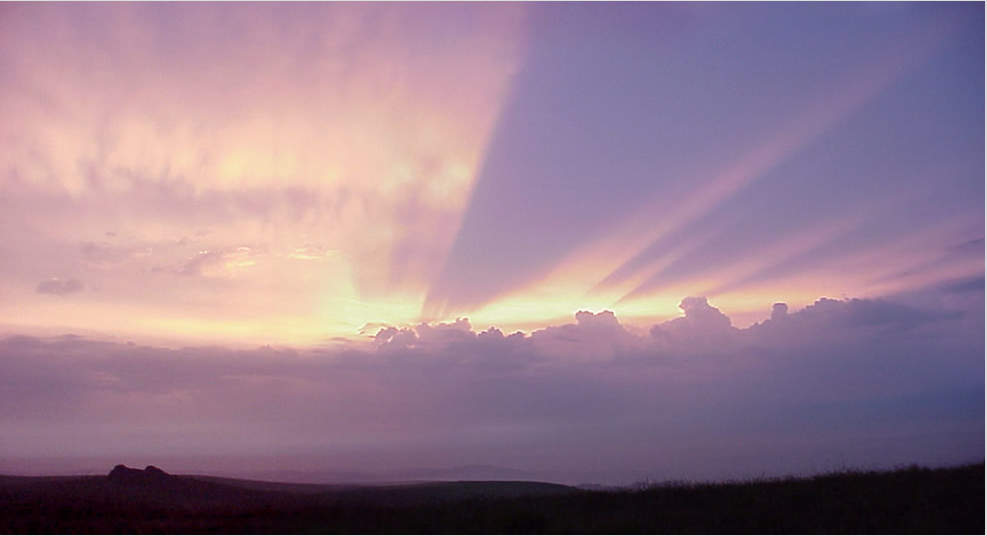Cloud Shadows - Dartmoor, England
Cloud Shadows - Dartmoor, England: A Spectacular Display of Atmospheric Optics
Dartmoor, England, known for its breathtaking landscapes, is also a prime location to witness the mesmerizing phenomenon of cloud shadows. On the morning of June 22nd, 2003, Richard Adams was fortunate enough to capture the beauty of this natural spectacle. As the sun rose over Dartmoor, swiftly changing rays and shadows danced across the landscape, creating a visual feast for the eyes. The backdrop of an ongoing electrical storm beneath the distant thunder clouds added an extra layer of drama to the scene.
Cloud shadows occur when sunlight interacts with clouds, casting darkened areas on the ground below. This captivating atmospheric optics phenomenon can be observed in various locations around the world, but Dartmoor's unique topography and ever-changing weather patterns make it an ideal spot for witnessing this spectacle.
One of the key factors that contribute to the formation of cloud shadows is the angle at which sunlight interacts with the clouds. As the sun rises or sets, its rays pass through the Earth's atmosphere at a more oblique angle, creating longer shadows. This angle of incidence plays a crucial role in the formation and intensity of cloud shadows.
The presence of cumulonimbus clouds, commonly associated with thunderstorms, adds an extra dimension to the display of cloud shadows. These towering clouds are capable of reaching great heights and casting large, dramatic shadows across the landscape. When an electrical storm is in progress beneath these thunderheads, as Richard Adams witnessed, the interplay between light and shadow becomes even more captivating.
The ever-changing nature of cloud shadows adds an element of unpredictability and excitement to their observation. As clouds move across the sky, their shadows shift and morph, creating an ever-evolving dance of light and dark on the ground below. This dynamic display can be particularly enchanting when witnessed in combination with other atmospheric phenomena such as rainbows or crepuscular rays.
To fully appreciate the beauty of cloud shadows on Dartmoor, it is essential to choose the right vantage point. Elevated locations that offer a wide expanse of view allow for a more immersive experience. Dartmoor's rugged terrain provides numerous vantage points, from rocky outcrops to rolling hills, offering photographers and nature enthusiasts ample opportunities to capture the magic of cloud shadows.
Capturing the essence of cloud shadows on camera can be a challenging yet rewarding endeavor. To effectively convey the depth and drama of this atmospheric phenomenon, photographers often employ techniques such as using a wide-angle lens to capture the expansive landscape and adjusting exposure settings to capture the subtle nuances of light and shadow.
Cloud shadows on Dartmoor are not limited to a specific time of year, but certain weather conditions can enhance their visibility and intensity. Days with a mix of sunshine and clouds, particularly when cumulonimbus clouds are present, offer the best chances of witnessing this captivating display. Patience and a keen eye for detail are key when seeking out these ephemeral moments of atmospheric beauty.
In conclusion, the cloud shadows that grace Dartmoor, England, are a testament to the captivating interplay between light, clouds, and the Earth's landscape. Witnessing this atmospheric optics phenomenon is a truly awe-inspiring experience, with ever-changing shadows casting an enchanting spell on those lucky enough to observe them. Dartmoor's unique topography and unpredictable weather patterns make it an ideal location for witnessing this natural spectacle. So, next time you find yourself in this stunning part of England, keep your eyes to the sky and be prepared to be mesmerized by the dance of cloud shadows across the landscape.

Sunrise over Dartmoor. Richard Adams (site) was greeted by swiftly changing rays and shadows on the morning of 22nd June 2003. An electrical storm was in progress beneath the distant shadow casting thunder heads. ©Richard Adams, shown with permission.
Note: this article has been automatically converted from the old site and may not appear as intended. You can find the original article here.
Reference Atmospheric Optics
If you use any of the definitions, information, or data presented on Atmospheric Optics, please copy the link or reference below to properly credit us as the reference source. Thank you!
-
<a href="https://atoptics.co.uk/blog/cloud-shadows-dartmoor-england/">Cloud Shadows - Dartmoor, England</a>
-
"Cloud Shadows - Dartmoor, England". Atmospheric Optics. Accessed on November 26, 2024. https://atoptics.co.uk/blog/cloud-shadows-dartmoor-england/.
-
"Cloud Shadows - Dartmoor, England". Atmospheric Optics, https://atoptics.co.uk/blog/cloud-shadows-dartmoor-england/. Accessed 26 November, 2024
-
Cloud Shadows - Dartmoor, England. Atmospheric Optics. Retrieved from https://atoptics.co.uk/blog/cloud-shadows-dartmoor-england/.